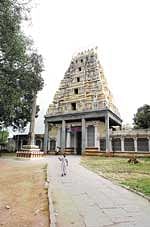Adversity & opportunity

Usha K R’s Monkey-man is gripping because he is devoid of myth and mystery — he’s made of reality with a slight shift. Inconsistently described by everyone from Neela Mary Gopalrao, conniving secretary to an influential man; Sukhiya Ram, her worldy-wise office boy; Pushpa Rani, a newly-minted call centre executive; and Shrinivas Moorty, a history lecturer in a local college, the Monkey-man on Ammanagudi Street drags you deep into the main characters’ past, where life moved slowly, predictably and painlessly. This, in sharp contrast to the present where cow pens have given way to call centres and mossy bungalows have been replaced by blocks of ratty, stifling apartments, unsettling and frightening an old-timer like Shrinivas Moorty.
Chronicling the human experience of the transformation of Bangalore from sleepy Cantonment to heaving Silicon City, Usha shines the spotlight on people like Shrinivas Moorty who have been affected adversely by the change, those like Pushpa Rani who have used it as an opportunity, and everyone inbetween like delicate Lily and stoic Mani nurse who feel nothing for what transpires outside their carefully structured lives.
Her evocative prose suits Shrinivas Moorty’s dark thoughts about a culture that has come to live by secrets and shallow thoughts embodied by cheeky youngsters like radio jockey Bali Brums who, with his faux cheer and drawl, rules the air waves in the morning, ruining Shrinivas Moorty’s appetite for a hearty South Indian breakfast.
A soft-boiled chap in a hard-boiled world, Moorty is forever looking back longingly to a past where he had been so happy, first as a feisty student dissecting potboilers like ‘Rani Mera Naam’ at India Coffee House or pedalling down Avenue Road in search of second-hand books, and then as an enormously conscientious lecturer running a film appreciation club for young, adoring students.
Painful battles
Watching him lose his secret love, his precious grants, and — finally — his battle against all that he holds sacred to his best friend-turned-baiter Jairam, you may find yourself willing him to be more desperate, more urgent, and less recognisably common. And when he encounters the truth of his life in a fleeting but intense moment, you are sure to gasp in physical pain.

It is intensely satisfying to read the stories of people like Moorty and Pushpa Rani who struggle to survive, who choose freedom over security and try to rise above their problems and circumstances. They are much closer to real life, in flesh and blood, than the winners like Jairam.
All the characters in this novel are rooted in Ammanagudi. For all its stress on the political landscape (Emergency in India, fall of USSR, rise of capitalism), the plot doesn’t stray far from the domestic hearth or the firewood depot on Ammanagudi Street. Despite the infiltration of towering glass-fronted buildings with names like Bhimaiah Plaza, Ammanagudi miraculously survives, drawing its inhabitants back and holding layers of history in its shadowy by-lanes and congested back alleys.
While this journey, back and forth in time, is sure to sear the heart of the south Bangalorean, I wonder if the other readers will understand or empathise with the sense of disenchantment and lost hope that the protagonist feels when he thinks the City is growing beyond his reach.
Like Ammanagudi Street, the story is crafty and layered, revealing the careful plan of its construction only towards the taut, twisted end. Again like the street, the story meanders a bit but it has the energy and the focus to sustain the meandering. It speaks powerfully of the past — of neighbourhoods without any particular charm, of houses without any particular distinction and of history that could soon be lost for all time.
Be it the peanut and pumpkin kootu with sandige served for Sunday lunch in Imperalist Radhakrishna’s house or Fanta and biscuits in Geeta’s house or the red wine served in thick steel tumblers smelling of onions in Jairam’s house, Usha weaves a rich tapestry of many convincing worlds. At times, the story moves with a breathtaking pace, so encounters with the many colourful minor characters like Mango Malini are short enough to leave the reader wanting more of them. But in many places the author conveys a huge amount of information about character and backstory through small but stunning detail.
Everyone is the hero of their own particular story be it Mani nurse or research scholar Alka, even though they intersect only slightly with the protagonist’s tale. Yet the narrative is not overcrowded as the characters are functional as the story moves close, lingers, moves back and moves on, in cinematic ways.
Usha’s quirky observations — she writes with an insider’s eye, her gentle humour, and her fascination for broken people are bound to draw you into the folds of Ammanagudi, where reality is always heightened and where all kinds of bizarre happenings like sightings of the Monkey-man flourish alongside mundane events like power cuts and road repairs.
Monkey-Man
Usha K R
Penguin, 2010,
pp 259, Rs 299
Deccan Herald is on WhatsApp Channels| Join now for Breaking News & Editor's Picks